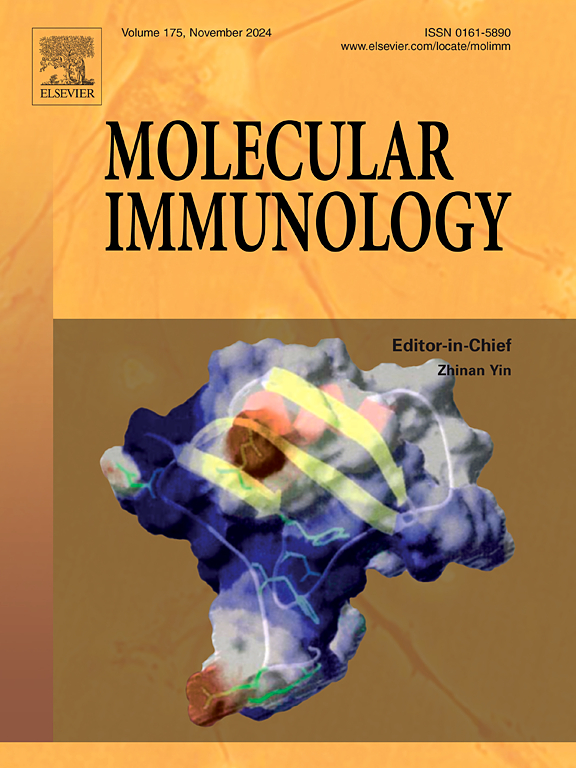虫草素通过smad7依赖的方式改善高糖诱导的肾小球系膜细胞的增殖、炎症和细胞外基质沉积
IF 3
3区 医学
Q2 BIOCHEMISTRY & MOLECULAR BIOLOGY
引用次数: 0
摘要
糖尿病肾病(DN)是终末期肾脏疾病最常见的原因之一。细胞外基质沉积是肾脏纤维化和损伤的重要致病因素。蛹虫草素(Cordycepin)是蛹虫草的一种天然核苷类化合物,已被证明具有保护肾功能。然而,Cor在DN中的作用及其机制尚未得到广泛的研究。本研究旨在探讨Cor对糖尿病小鼠模型和高糖诱导小鼠肾小球系膜细胞(GMCs)的保护作用及其机制。生化指标分析结果显示,肾素可改善肾功能,降低血清肌酐、血尿素氮和尿蛋白。组织学评估进一步证实,Cor改善了肾脏的病理改变,包括系膜基质扩张、肾小球基底膜增厚、肾小球硬化和原纤维胶原沉积。此外,Cor还能减轻高糖诱导的GMCs细胞增殖和纤维化。在机制上,Cor上调Smad7的表达,抑制TGF-β/Smad通路的激活及其下游nox4介导的NLRP3炎性体。此外,通过shRNA转染敲低Smad7可消除Cor在高糖诱导的GMCs中的抑制作用。这些发现表明,Cor代表了一个有希望的治疗候选人减轻肾脏损害的糖尿病肾病。其潜在机制涉及Smad7表达的增强,进而抑制TGF-β/Smad信号传导和nox4介导的NLRP3炎症小体激活。本文章由计算机程序翻译,如有差异,请以英文原文为准。
Cordycepin ameliorates high glucose-induced proliferation, inflammation, and extracellular matrix deposition in glomerular mesangial cells through Smad7-dependent manner
Diabetic nephropathy (DN) is one of the most common causes of end-stage renal disease. The extracellular matrix deposition is potent pathogenic factors of renal fibrosis and injury. Cordycepin (Cor), a natural nucleoside compound from Cordyceps militaris, has been demonstrated reno-protective properties. Nevertheless, the role and underlying mechanism of Cor in DN have not been studied extensively. This study aimed to investigate the renal protective effects and mechanism of Cor on diabetic mouse models and high glucose (HG) induced-mouse glomerular mesangial cells (GMCs). The results of the biochemical indicators indicated that Cor could ameliorate renal dysfunction, as evidenced by reductions in serum creatinine, blood urea nitrogen, and urinary protein. Histological evaluation further confirmed that Cor ameliorated renal pathological changes, including mesangial matrix expansion, glomerular basement membrane thickening, glomerulosclerosis, and fibrillar collagen deposition. Additionally, Cor alleviated cell proliferation and fibrosis induced by high glucose in GMCs. Mechanistically, Cor upregulated the expression of Smad7, suppressed TGF-β/Smad pathway activation and its downstream NOX4-mediated NLRP3 inflammasome. Furthermore, knockdown of Smad7 by shRNA transfection abrogated the inhibiting effects of Cor in high glucose-induced GMCs. These findings suggested that Cor represented a promising therapeutic candidate for mitigating renal damage in diabetic nephropathy. The underlying mechanism involved the enhancement of Smad7 expression, which in turn suppresses TGF-β/Smad signaling and NOX4-mediated NLRP3 inflammasome activation.
求助全文
通过发布文献求助,成功后即可免费获取论文全文。
去求助
来源期刊

Molecular immunology
医学-免疫学
CiteScore
6.90
自引率
2.80%
发文量
324
审稿时长
50 days
期刊介绍:
Molecular Immunology publishes original articles, reviews and commentaries on all areas of immunology, with a particular focus on description of cellular, biochemical or genetic mechanisms underlying immunological phenomena. Studies on all model organisms, from invertebrates to humans, are suitable. Examples include, but are not restricted to:
Infection, autoimmunity, transplantation, immunodeficiencies, inflammation and tumor immunology
Mechanisms of induction, regulation and termination of innate and adaptive immunity
Intercellular communication, cooperation and regulation
Intracellular mechanisms of immunity (endocytosis, protein trafficking, pathogen recognition, antigen presentation, etc)
Mechanisms of action of the cells and molecules of the immune system
Structural analysis
Development of the immune system
Comparative immunology and evolution of the immune system
"Omics" studies and bioinformatics
Vaccines, biotechnology and therapeutic manipulation of the immune system (therapeutic antibodies, cytokines, cellular therapies, etc)
Technical developments.
 求助内容:
求助内容: 应助结果提醒方式:
应助结果提醒方式:


